Intercooler and Radiator
Page © Copyright 2004 Chuck Kopelson 05/04/2004
Updated August 2, 2006
While a charge air cooler otherwise known as an intercooler is not part of the cooling system, the charge air cooler lowers the temperature of the intake air. By doing so, there is an increase in the engine's combustion temperature and, in turn, an increase in the efficiency of the combustion cycle. By utilizing more of the generated heat for energy, there is a reduction in the amount of excess heat generated that must be taken away by the cooling system.
An intercooler is a radiator that cools the air exiting the turbo before it gets into the engine. The turbo is an air compressor that takes outside air and squeezes it down so it becomes denser / under higher pressure. A byproduct of compressing the air is heat. That's why an air compressor has cooling fins on it's cylinders. An intercooler lowers the temperature of the compressed air making it denser.
Intercoolers are almost always found on semi tractors. A properly operating charge air cooler can reduce excess heat by as much as 40% in a modern diesel. Intake air temperatures are now within the 110-degree F range in comparison with older diesels that operated with intake temps above 180 degrees F.
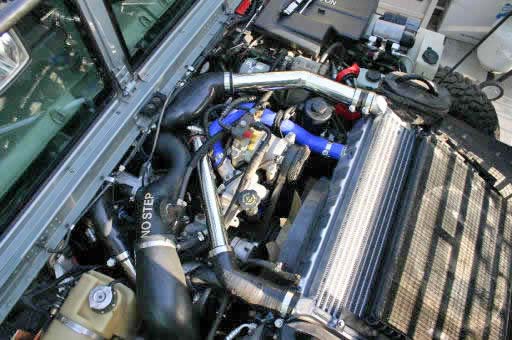 I Just had an intercooler installed on my 2000 wagon! It was designed by Dennis Sweeney (775) 970-3516 and the install was done by Jim Clip up in Reno, NV. These guys are both top notch and know a hell of a lot about Hummers. The installation is a bit on the involved side, but overall is a very nice fit and finish, albeit with a few tight spots around the new intake manifolds (which I would come to know very well, as one hose would have to be replaced by me).
I Just had an intercooler installed on my 2000 wagon! It was designed by Dennis Sweeney (775) 970-3516 and the install was done by Jim Clip up in Reno, NV. These guys are both top notch and know a hell of a lot about Hummers. The installation is a bit on the involved side, but overall is a very nice fit and finish, albeit with a few tight spots around the new intake manifolds (which I would come to know very well, as one hose would have to be replaced by me).
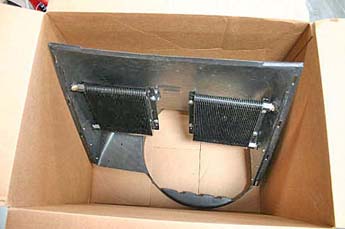

The kit includes an entire new fan shroud which houses 2 transmission oil coolers, and one engine oil cooler. There is a huge aluminum radiator and intercooler with all the associated hoses, stainless steel tubes and hardware. There is an additional 2nd transmission oil cooler just above the radiator in the front.
I had previously installed a stainless exhaust system, and computer upgrade that would compliment the intercooler install. It took about 3 days with extra accessories (over a long weekend to do the install). If it is just the intercooler it can be done in a day, 2 days max.
I also had a Westech EGT/Boost gauge installed where the Voltmeter used to sit, and moved the voltmeter to the Clock's old spot (Thanks Chuck Kopelson for your excellent detailed instructions on the install!)
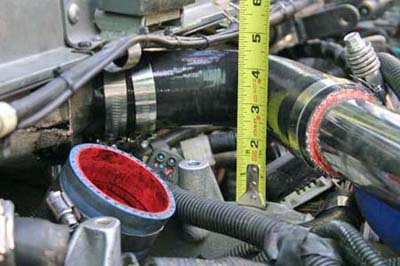 Like I said, the install is very tight, and Dennis tells me the amount of room for installation varies by Hummer. As my luck would have it, this truck was one of the tightest he has seen. All the body mounts have been crushed down, leaving little room everywhere. Even the radiator between the pillars was a tight fit. Mine had less than an 1/8" clearance while some Dennis has seen have as much as 3/4". I think a 2" body lift would be really sweet in this setup to gain much needed clearance, but then you need to go with at least 40" tires to make the truck look good (in my opinion).
Like I said, the install is very tight, and Dennis tells me the amount of room for installation varies by Hummer. As my luck would have it, this truck was one of the tightest he has seen. All the body mounts have been crushed down, leaving little room everywhere. Even the radiator between the pillars was a tight fit. Mine had less than an 1/8" clearance while some Dennis has seen have as much as 3/4". I think a 2" body lift would be really sweet in this setup to gain much needed clearance, but then you need to go with at least 40" tires to make the truck look good (in my opinion).

The blue hoses in the pics are silicone that carry the radiator fluid, the black hoses are silicone as well for the intercooler. It definitely looks cool.
The first thing you notice is the throttle response. It is crisp and quick. Reno is about 6000 foot elevation, so I was not expecting to get much power up there. I was wrong! Traveling between 6 and 8000 feet was absolutely amazing! Dennis had forewarned me not to expect "stoplight to stoplight" drag race power. He was correct. What is different is the amount of Torque the vehicle has, and how well it pulls on the highway.
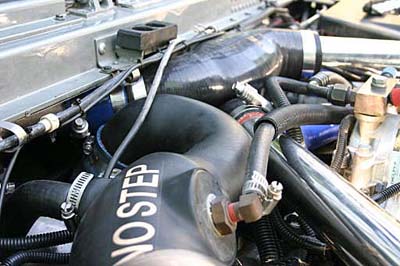
Before the intercooler, ANY hills attempted would result in the truck dropping to third and going about 45-50MPH (not towing anything, lightly loaded). Now, it ACCELERATES up hills in overdrive, where I have to back off the throttle! And this was at 6-8000 feet! It can accelerate passed 80 mph no problem (which I do not intend to do anyway). I also notice lower engine RPMS for any given speed. Traveling 70 your at about 2350RPM, where it was at 2500 before. Passing people on the highway is now an option, as compared to a risk before!
As for coolant temps, they are similar to before, but I do notice it seems to go back to normal operating temps quicker after pulling a long hill. Probably because the radiator is aluminum. Dennis told me the aluminum radiator would not make the truck run cooler, just be more efficient.
BTW, I had a hood scoop before doing all this with an aux fan and spacer between radiators, which never did anything in my opinion. Went back to the original hood grill, and no aux fan, and the temps are perfect.
Overall my initial impressions are outstanding... I could not be happier. Well worth the time and effort getting it installed. My truck has been reborn!
It is nice to have the EGT/Boost gauge now....I only wish I had them before I did the mods, to give me an idea of what the actual performance differences are now. The idea of making the truck run cooler has been a long debated issue. I think the general consensus is that because of the design of the truck, the temps fluctuate within and acceptable range (my truck between 195-220 without ever overheating). This is considered normal behavior.
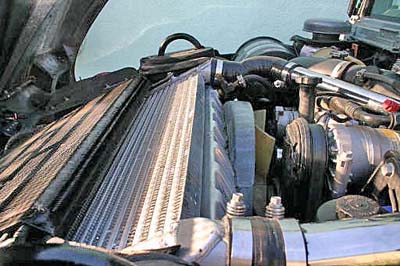
So far, I have seen my trucks' temp gauge live in about the same zone, although I think it goes back to normal temp quicker after being under load. Climbing a hill, 6000-8000 feet, ambient air at 80-85, hitting it hard in a few spots..... the water temps were at around 210, EGT's never over 800, and boost from 8-11 PSI under load. And as soon as you hit a downhill, temps went down quick. Actually, the EGT's fluctuate VERY quickly when you let off the gas.
Cruising on the freeway you see 3-5 PSI on the boost 300-400 on the EGT temps... Under slight load you get in the 6-8 PSI range on boost, and 400-600 on EGT's. It's getting HOT here in L. A. now, so I will gather more info on hot weather performance in the months ahead.
As for costs, you will be in the 4K + range with labor to do the install... Of course that depends on how much stuff you have done to the truck.
For those of you interested, I have some observations on my new Intercooler's' performance in hot weather. As some of you know, it has been HOT here in L. A., especially in the San Fernando Valley. Temps have been in the 95-107 range (depending on the geographic area) for a few days now. Here is what I have seen....
Ambient temps about 100-104, A/C on, climbing a steady 8% grade 65mph in overdrive, about 210-215 water temp, 9-10 PSI boost, never over 800 on the EGT's. The engine fan is on all of the time.
Twisty canton road (Malibu Canyon)up and down grades, ranging temps from 104 inland to 78, 205-210 water temps, 3-11 PSI varying boost, never over 700 on the EGT's. The engine fan is on most of the time.
Cruising freeway ambient temp 100-107 no hills or load, 200-210 water temps, 3-4 PSI boost, never over 500 on EGT's. Engine fan is on a lot of the time, but if going slightly downhill, it shuts off.
From what I have been noticing, the water temps have been hovering about 5-10 degrees higher than before the intercooler was installed. I haven't figured out just why this is so, but a preliminary guess might be how the hood is now sitting around the radiators. I might take the time to try and seal around the top of the cooling stack, to increase airflow through the shroud more efficiently. That's how it used to be before the mods.
BUT.... the EGT's are most definitely cooler. I know the following is not exactly definitive research, but before the intercooler was installed, in hot weather or being under load climbing hills, if I put my fingers around the parking break housing, the heat in there was scalding. Now, in the same situation with the intercooler installed, it is MILDLY warm. Sometimes hardly that. I think that is a HUGE difference.

